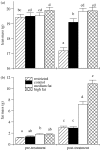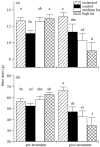Having it all: historical energy intakes do not generate the anticipated trade-offs in fecundity
- PMID: 16777725
- PMCID: PMC1560301
- DOI: 10.1098/rspb.2005.3456
Having it all: historical energy intakes do not generate the anticipated trade-offs in fecundity
Abstract
An axiom of life-history theory, and fundamental to our understanding of ageing, is that animals must trade-off their allocation of resources since energy and nutrients are limited. Therefore, animals cannot "have it all"--combine high rates of fecundity with extended lifespans. The idea of life-history trade-offs was recently challenged by the discovery that ageing may be governed by a small subset of molecular processes independent of fitness. We tested the "trade-off" and "having it all" theories by examining the fecundities of C57BL/6J mice placed onto four different dietary treatments that generated caloric intakes from -21 to +8.6% of controls. We predicted body fat would be deposited in relation to caloric intake. Excessive body fat is known to cause co-morbidities that shorten lifespan, while caloric restriction enhances somatic protection and increases longevity. The trade-off model predicts that increased fat would be tolerated because reproductive gain offsets shortened longevity, while animals on a restricted intake would sacrifice reproduction for lifespan extension. The responses of body fat to treatments followed our expectations, however, there was a negative relationship between reproductive performance (fecundity, litter mass) and historical intake/body fat. Our dietary restricted animals had lower protein oxidative damage and appeared able to combine life-history traits in a manner contrary to traditional expectations by having increased fecundity with the potential to have extended lifespans.
Figures






References
-
- Austad S.N. Comparative ageing and life histories in mammals. Exp. Gerontol. 1997;32:23–38. 10.1016/S0531-5565(96)00059-9 - DOI - PubMed
-
- Clancy D.J, Gems D, Harshman L.G, Oldham S, Stocker H, Hafen E, Leevers S.J, Partridge L. Extension of life-span by loss of CHICO, a Drosophila insulin receptor substrate protein. Science. 2001;292:104–106. 10.1126/science.1057991 - DOI - PubMed
-
- Covas R, Brown C.R, Anderson M.D, Bomberger Brown M. Stabilizing selection on body mass in the sociable weaver Philetairus socius. Proc. R. Soc. B. 2002;269:1905–1909. 10.1098/rspb.2002.2106 - DOI - PMC - PubMed
-
- Fisher R.A. Clarendon Press; Oxford, UK: 1930. The genetical theory of natural selection.
-
- Guarente L, Kenyon C. Genetic pathways that regulate ageing in model organisms. Nature. 2000;408:255–262. 10.1038/35041700 - DOI - PubMed
Publication types
MeSH terms
LinkOut - more resources
Full Text Sources
Other Literature Sources

